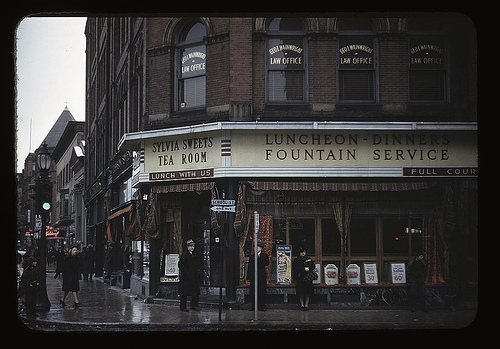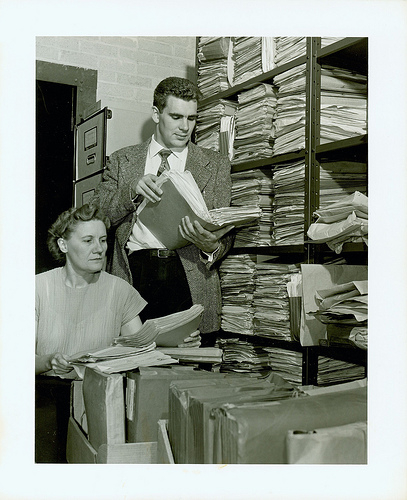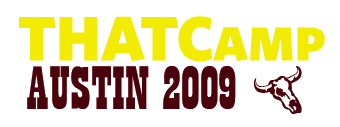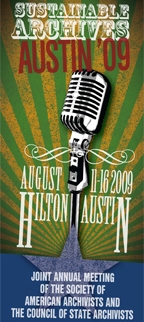 Andrew Flinn, University College London (UCL), was the second speaker during SAA09’s Session 202 with his presentation ‘A History of Our Own, Representing Communities and Identities on the Web’. Flinn began with the idea that archives are “a place for creating and re-working memory”. While independent community archives are constituted around many purposes, Flinn’s main interest is in communities focused on absences and mis-representation of a group or event in history. Communities in which there is a cultural, politcal, or artistic activism. Some of these communities may be considered ‘movements’.
Andrew Flinn, University College London (UCL), was the second speaker during SAA09’s Session 202 with his presentation ‘A History of Our Own, Representing Communities and Identities on the Web’. Flinn began with the idea that archives are “a place for creating and re-working memory”. While independent community archives are constituted around many purposes, Flinn’s main interest is in communities focused on absences and mis-representation of a group or event in history. Communities in which there is a cultural, politcal, or artistic activism. Some of these communities may be considered ‘movements’.
How should/can archivists support local archiving activities?
Part of the challenge of online communities is the need to capture the interactions in order to not loose the full picture. The National Listing of Community Archives in the UK‘s website states that they “seek to document the history of all manner of local, occupations, ethnic, faith and other diverse communities”.
The UCL’s International Centre for Archives and Records Management Research and User Studies (ICARUS) “brings together researchers in user access and description, community archives and identity, concepts and contexts of records and archives, and information policy”. Flinn is the Principal Investigator on the ICARUS project Community archives and identities which focuses on in depth interviews of 4 institutions which are “documenting and sustaining community heritage”.
These are some example online community sites:
- rukus – black gblt archives
- Moroccan Memories in Britain
- eside community – east side working class community in London
Main Findings
- proceed from a position that ‘knowing your own history’ is beneficial their communities as well as to the public at large
- the quality of the work is done by individual passion and sacrifice, voluntary
- there is ambivalence to/about the mainstream archives sector — keen to work with mainstream archives, but scarred by past bad experiences
- good practices now could lead to partnerships in the future
- these are living archives — not static.. still alive and growing
- these ideas prompt re-evaluation of conventional archives thinking
- lots of access to digital objects – perhaps movement to online existence
We need to understand that these communities evolve and are fluid. They have as broad variety of structures, sizes and methods of working. What are the patterns in participation & ownership?
The site urban 75 has hosted extended discussions about recent UK history. Efforts include identification of places and people in uploaded photos. The site connects people about issues about housing and local services – it is very practical but it also has evolved to include this historical documentation. One example post from the Brixton Forum shows a discussion about an Old shop front revealed on Atlantic Road.
A Short Aside
Next Flinn apologized for taking his talk slightly off script. Setting his papers aside, he spoke to the audience about the eXHulme website which he had discovered the evening before while finishing his presentation. Having lived in Hulme, Manchester himself, he felt a great impact from looking through the site. He spent 4 hours looking at it – including photos such as the travellers living in their buses parked – otteburn close 1996 seen at the bottom of this page. His discovery and exploration of this site gave him a greater personal understanding of the impact of these types of community documentation projects. I felt he would have been happy to keep talking about this site and the directions it had sent his thoughts — but he then got back to his papers and continued.
Building Community Online
Interactions online are the historic record of the community itself. Archives evolve and change as the community builds and edits their online content. These heritage and archive sites work to shift from the idea of visitors to engaging users in interaction — they need users of the website to feel part of the community.
Examples of sites building community online:
- My Brighton and Hove – community history site
- Remembering Olive Collective – “social production of collective knowledge”
- The Newham Story — uses social tagging
How do you successfully encourage participation (rather than large number of passive observers) which is crucial to the success of these types of initiatives? Lurking without contributing is easy – even if joining requires action. The rate of uptake may correspond with the sense of ownership. Heritage projects might encourage and sustain such participation. See Elisa Giaccardi & Leysia Palen’s article – The Social Production of Heritage through Cross-media Interaction: Making Place for Place-making.
Suggestions
- encourage conversation and treat all stories as having value – value every account
- promote a sense of ownership once a story has been shared
- allow for multiple ways to engage with and share content and memories
- recognize and let users shift from observer to active member
Flinn’s Conclusions
- What are the challenges and perils facing community archives? Lack of resources. People are doing these things in unsustainable ways
- Why should we sustain independent community archives? Benefit to individuals, communities and broader society.
- What can professional archivists do? Support and partnership with groups seeking this sort of partnership.
My Thoughts
The image I included above is from the Library of Congress’s Flickr Commons project. If you read through the comments on this photo you can see a diverse group of individuals come together to document the history of Sylvia Sweets Tea Room. This is just another example of the process of documentation being as interesting as the original image itself.
There is still so much to learn in the arena of building productive online communities. Archivists working through how to archive what online communities create will need to understand how the process of creation is documented via various software tools. As the techniques for encouraging participation evolve – archivists will need to evolve right along with them. I think it is interesting to envision archivists working in this space and supporting these types of communities — becoming as much the champions of the community itself as preservers of a community’s collaborative creations.
Image Credit: Flickr Commons Library of Congress: Sylvia Sweets Tea Room, corner of School and Main streets, Brockton, Mass
As is the case with all my session summaries from SAA2009, please accept my apologies in advance for any cases in which I misquote, overly simplify or miss points altogether in the post above. These sessions move fast and my main goal is to capture the core of the ideas presented and exchanged. Feel free to contact me about corrections to my summary either via comments on this post or via my contact form.


 It is official – the panel I proposed for SAA 2009 (aka, Sustainable Archives: AUSTIN 2009) was accepted!
It is official – the panel I proposed for SAA 2009 (aka, Sustainable Archives: AUSTIN 2009) was accepted!